Inle Lake
Being a mesmerizing area of natural beauty as well as cultural diversity, the lake of Inle is absolutely an attractive destination for your tour in Shan State, Myanmar. The attraction is so famous that if you talk the word ‘Inle’, immediately people will think of ‘Inle Lake’.
Read More
QUICK FACT:
- Location: 30 km south of Taunggyi
- Status: Myanmar’s second largest freshwater lake
- Population: about 150 000
- Area: 116 square km
- Best time to visit in a year: from October to
- Mar Among the most picturesque attractions of Myanmar and even in Southeast Asia as well, known as “Venice of the East”
At an altitude of 880 meters and an estimated surface area of 116 square kilometers, Inle Lake is the one of the highest and the second largest freshwater lake in Myanmar.
In addition, Inle is the habitat of a considerable number of endemic species with over nine species of fish and twenty species of snails which are nowhere else in the world to be found.
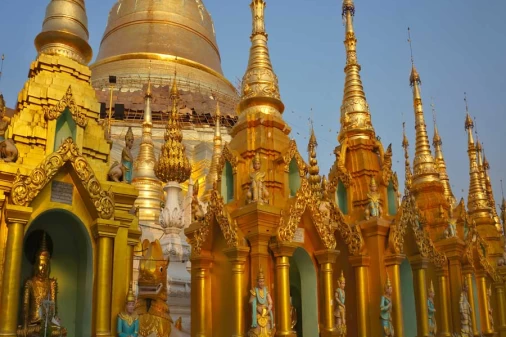
Alodaw Pauk Pagoda
It lies in Nampan Village. Nyaung Shwe Township. southern Shan State. It was one of the 84000 pagodas...
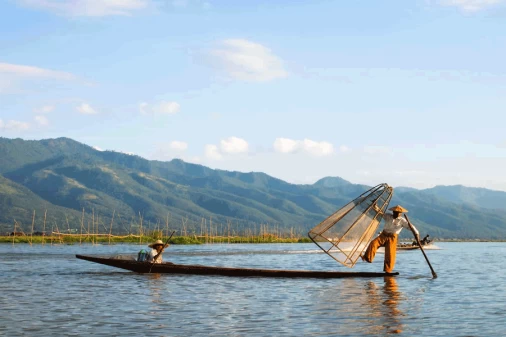
Inle Lake
Description: Inle Lake is situated in the hilly Shan State in the eastern part of Myanmar. With an elevation...
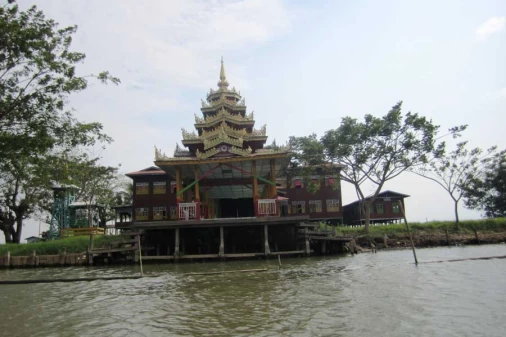
Nga Phe Chaung Monastery
Nga Phe Chaung Monastery, which is located in Inle Lake, is an attractive wooden monastery built at...
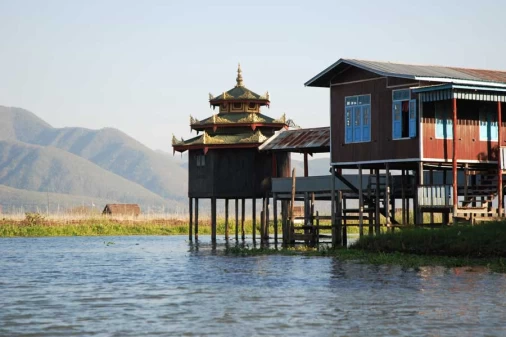
Nga Phe Kyaung Monastery
Nga Phe Kyaung Monastery.The Nga Phe Kyaung is the biggest and oldest monastery in Inle Lake. It is...
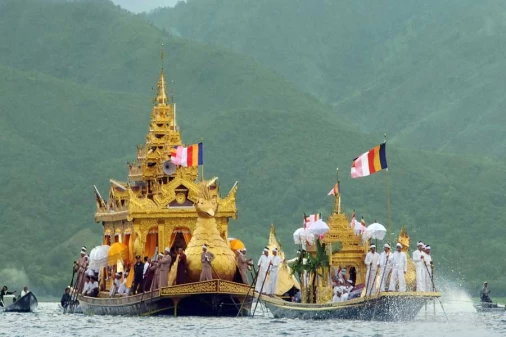
Phaung daw Oo Pagoda
Located on the great Inle Lake, Phaung Daw Oo Pagoda is one of the prominent sites in Shan State and...
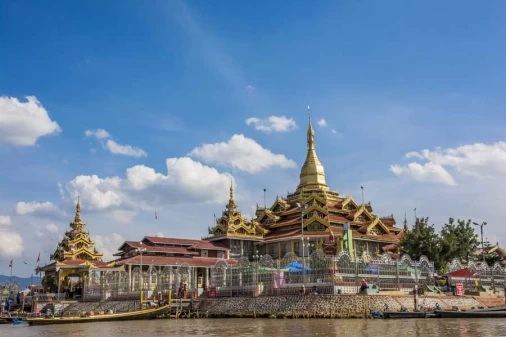
Sagar
Descriptions: A boat trip to the village of Sagar is beyond your imagination. Gazing at the blue hazy...
Frequently asked questions
Inle Lake is situated in the hilly Shan State in the eastern part of Myanmar. With an elevation of 900 meters above sea-level, it is one of the main tourist attractions in Myanmar. The lake, 22 km long and 10 km wide, has a population of some 150,000, many of whom live on floating islands of vegetation. Inle Lake, natural and unpolluted, is famous for its scenic beauty and the unique leg-rowing of the Inthas, the native lake-dwellers. Moreover, floating villages, colorful daily floating market and Inle Spa are places worthy of visit. The festival of Phaung-daw-Oo Pagoda in Inle Lake held during October is full of pageantry and colorful splendor.
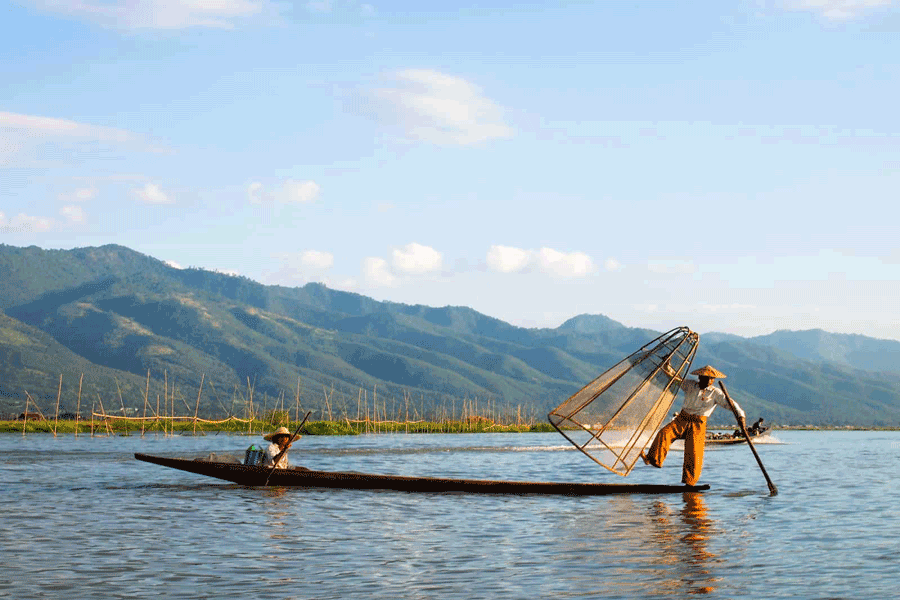 The most convenient way is to fly from Yangon to Heho, which is the nearest airport to the lake. There are daily flights to Heho which take about an hour. If you are flying from Mandalay to Heho, it takes only 20 minutes. Traveling by car along the uphill and winding road over the Shan Plateau is interesting and well-worth taking although it takes long hours. There is also a regular train service via Thazi Junction to Heho and Shwenyaung, the nearest station to the lake
The most convenient way is to fly from Yangon to Heho, which is the nearest airport to the lake. There are daily flights to Heho which take about an hour. If you are flying from Mandalay to Heho, it takes only 20 minutes. Traveling by car along the uphill and winding road over the Shan Plateau is interesting and well-worth taking although it takes long hours. There is also a regular train service via Thazi Junction to Heho and Shwenyaung, the nearest station to the lake
Ngaphechaung Monastery (Famous Jumping cat monastery).Out in the open lake is a monastery with 157 years` history.Supported by 654 teak pillars of which 200 are gilded in gold,it houses 6 golden Buddha stat-use of varying sizes.
Phaung Daw Oo Festival Once a year the peaceful scenery at Inle Lake is filled with joy and excitement. The famous Phaung Daw Oo Festival which is held at the lake every October. The procession start at the end of Buddhist Lent and it goes on for about 19 days till the Karaweik (water bird), and the four Buddha images are rowed back to Phaung Daw Oo Pagoda.
The procession of the Inle leg-rowers in full pageantry and plendour.
Ywama is the largest village on the Lake; its streets are a web of canals. There are some beautiful teak houses built on large wooden piles driven into the lake bed. The main activity and attraction center at the floating market in the largest canal.
Kakku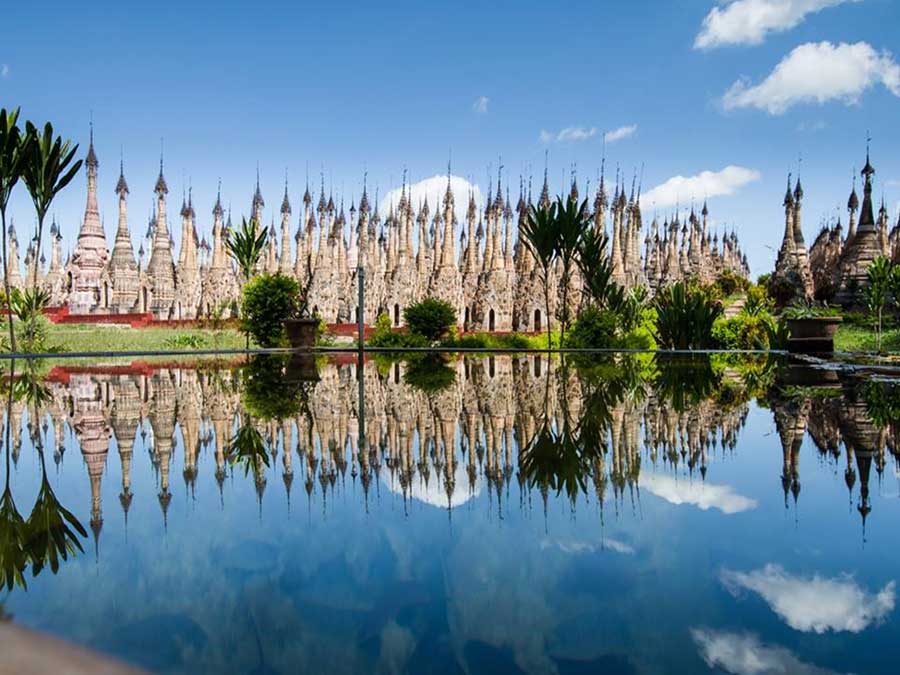 Kakku is a hidden treasure an unusual, magnificent collection of Buddhist Stupas unheard of by historians and unlisted in guide books lies in the deepest Pa-oh territory, 26 miles south of Taunggyi the capital of Shan State. There lies more than 2000 stupas in a site closely packed together in ranks covering an area of approximately a square kilometer apparently unknown to outside world. Kakku area is covered and scattered by Pa-oh villages especially stretching along on both sides of the main road from north to south.
Kakku is a hidden treasure an unusual, magnificent collection of Buddhist Stupas unheard of by historians and unlisted in guide books lies in the deepest Pa-oh territory, 26 miles south of Taunggyi the capital of Shan State. There lies more than 2000 stupas in a site closely packed together in ranks covering an area of approximately a square kilometer apparently unknown to outside world. Kakku area is covered and scattered by Pa-oh villages especially stretching along on both sides of the main road from north to south.
The land route for tour groups starting from Taunggyi is possible and accessible for all year round. But tours originated from Inle Lake are considered to be possible only in the open season from late October to early May or before heavy rain falls. The yearly religious festival normally takes about one week. The climax of this festival usually falls on fullmoon of the Tabaung (Mid-March) every year. The Kakku pagodas festival also draws thousands of visitors from all parts of the Shan State.
Sagar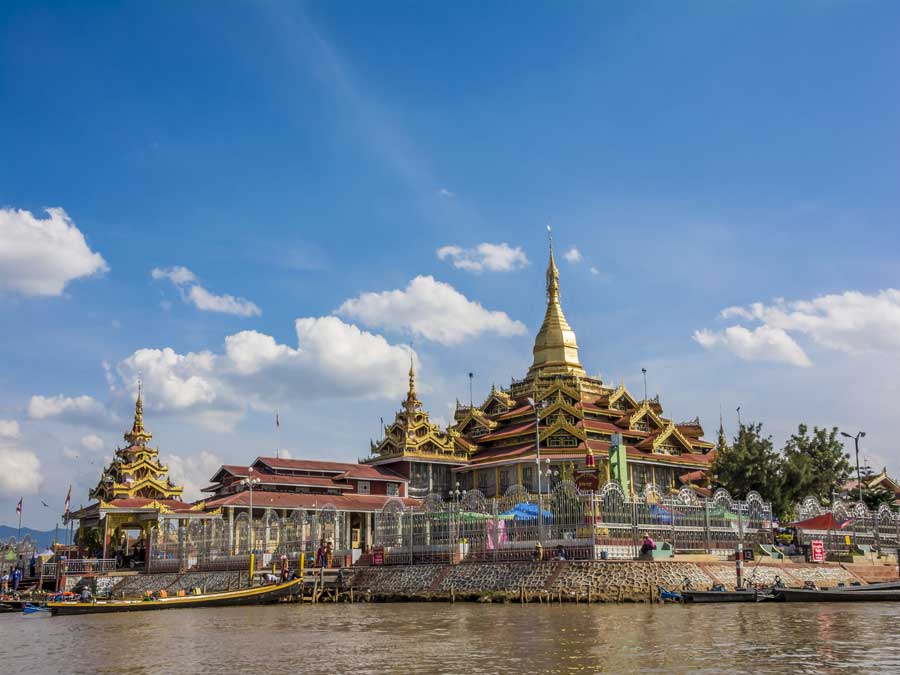 A boat trip to the village of Sagar is beyond your imagination. Gazing at the blue hazy mountains, feeding groups of water birds that are chattering here and there on the Lake, scattering floating vegetations and happy-and-content Inthas (native to the Lake Inle) in their leg-rowing small boats .. are some unique spices appetizing those who are hungry for nature and cleanly environs.
A boat trip to the village of Sagar is beyond your imagination. Gazing at the blue hazy mountains, feeding groups of water birds that are chattering here and there on the Lake, scattering floating vegetations and happy-and-content Inthas (native to the Lake Inle) in their leg-rowing small boats .. are some unique spices appetizing those who are hungry for nature and cleanly environs.
The Sagar village, once must have been a thriving town of Sawbwa (the heredity prince), is a place of unexplored. All are intact and unspoiled. Reach up the Sagar village which takes a half-day boat ride. There you find blushing faces of Pa-O tribe, welcoming smiles of the villagers amidst the dotting religious buildings (pagodas & monasteries). Witness the two Ms (Maze & Mystery) there and let the solution be found in your own tune when you come in Sagar.
Day 1: Inle Lake Boat Tour
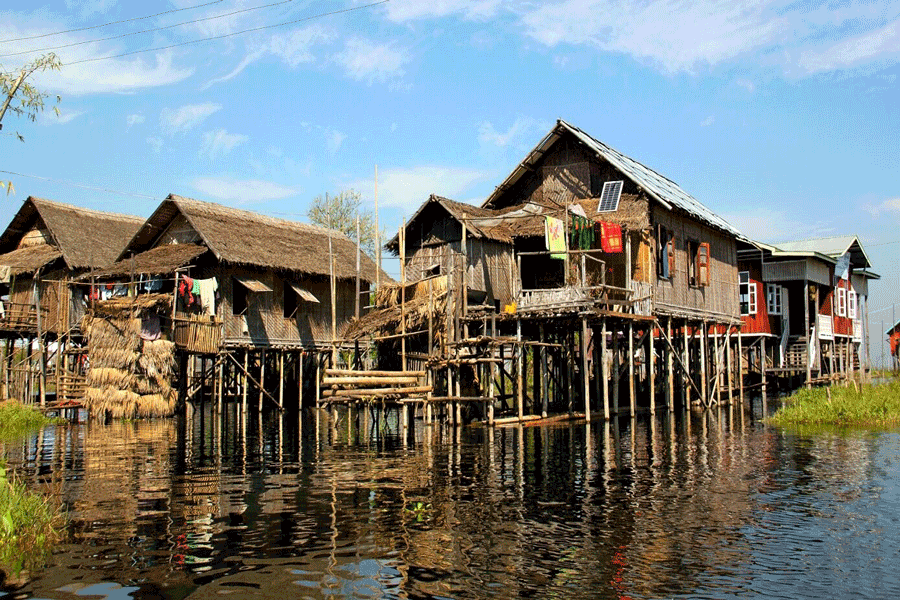 As the sun rose above the waters of the misty lake, we watched villagers tend to their gardens. We watched children float by on their way to school. We watched as mothers washed dishes and clothes at the water’s edge.
As the sun rose above the waters of the misty lake, we watched villagers tend to their gardens. We watched children float by on their way to school. We watched as mothers washed dishes and clothes at the water’s edge.
The 116 square kilometer lake is home to a large population of Intha fishermen. The Intha people are the primary inhabitants of Inle Lake. They live in stilted houses, cultivate crops in their floating gardens, row to their schools in hollow wooden boats and practice a unique leg-rowing tradition that dates back to the 12th century.
As we traversed the lake by boat, we passed silhouettes of leg-rowing fisherman that were paddling in this distinctive standing position with one foot wrapped around the paddle.
The Inle lake fake fishermen are a group of men looking to score a few kyat by posing flamingo-style on their boats in a reenactment of traditional rowing methods.
Day 2: Burmese Cooking Class and Winery Visit
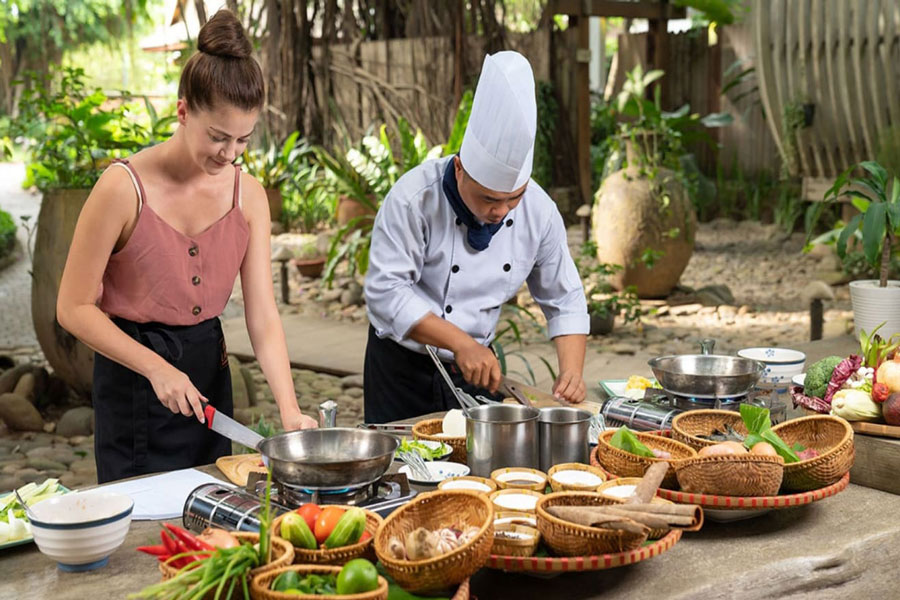 After a successful boat tour around Inle Lake, we spent the following day at Nyaung Shwe’s Bamboo Delight Cooking School. With our local guide, we wandered the maze of market stalls in search of ingredients and spent the afternoon learning how to make tasty curries and salads. The Burmese cooking class was a whole day affair and culminated in one of the best feasts I’d had during my travels in Asia. The setting was intimate and homey and the food was delicious and plentiful.
After a successful boat tour around Inle Lake, we spent the following day at Nyaung Shwe’s Bamboo Delight Cooking School. With our local guide, we wandered the maze of market stalls in search of ingredients and spent the afternoon learning how to make tasty curries and salads. The Burmese cooking class was a whole day affair and culminated in one of the best feasts I’d had during my travels in Asia. The setting was intimate and homey and the food was delicious and plentiful.
Day 3: Exploring Inle Lake by Bicycle
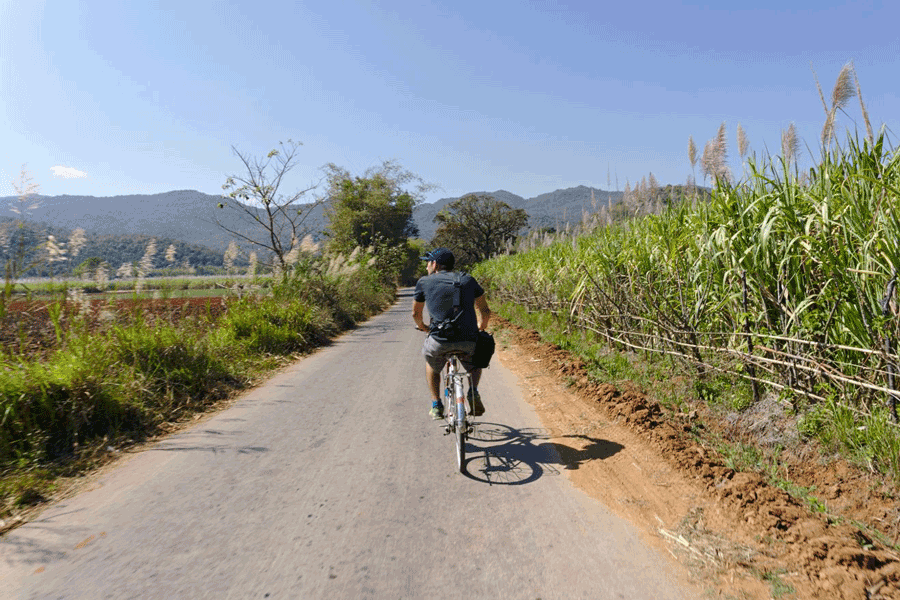 This day exploring Inle Lake by bicycle with very diffirent experiences.
This day exploring Inle Lake by bicycle with very diffirent experiences.
Following a hand drawn map provided by my hostel’s front desk, I got lost down winding roads, ate my way through bustling markets and caught glimpses of local life on the lakeshore. I saw farmers using water buffalo to plow their fields, women with wide-brimmed hats planting rice and children chasing dogs down dusty streets.
Inle Lake is a delightful and lively place that offers a variety of food from local Inthar dishes or Shan cuisine to more Western-style cuisines with below suggestion:
Ann’s Restaurant
Ann’s Restaurant sets amongst the spectacular bamboo forest, indulge in superb Intha specialties straight from the Shan kitchen.
Place to eat: Myan Ni Gone Village, Nha Phay Kyaung P.O
Aroma Restaurant
It specialises in Indian food, and also has a branch in the ancient city of Bagan. The tasty Indian meat and vegetable curries are worthtrying
Place to eat: Chaung Road
Four Sisters Restaurant/Inn
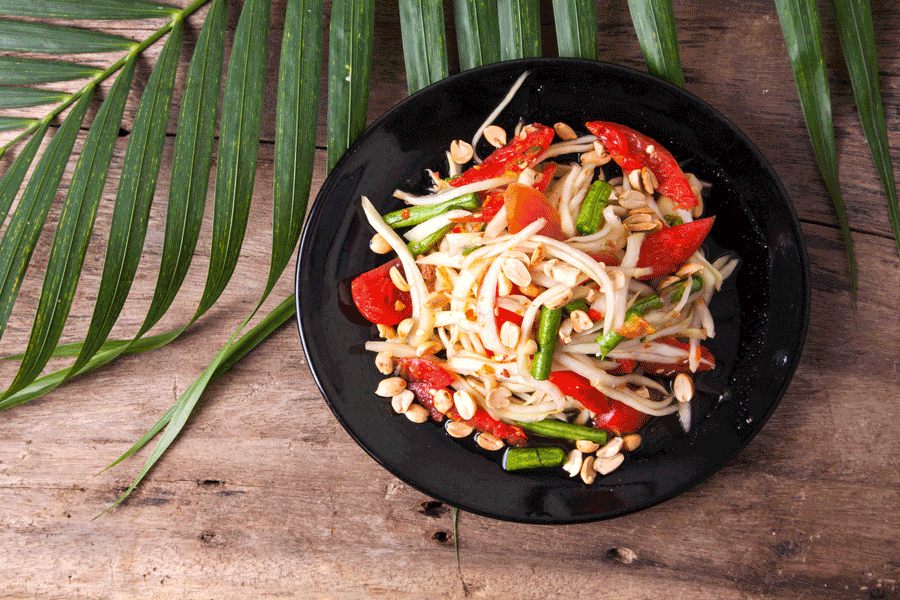 Four Sisters Inn used to be a successful restaurant. Now, they expanded their restaurant business into a quiet small guesthouse. They do not only serve excellent Shan kitchen, but accompany the meal also frequently with music and dance.
Four Sisters Inn used to be a successful restaurant. Now, they expanded their restaurant business into a quiet small guesthouse. They do not only serve excellent Shan kitchen, but accompany the meal also frequently with music and dance.
Place to eat: 105, Strand Road, Nan Pan Quarter, Nyaung Shwe
Golden Kite Restaurant
The Golden Kite specializes in authentic Italian food. The menu also incorporates other European dishes, but the pizza and pasta are uncommonly good at fair prices and a good atmosphere.
Place to eat: Yone Gyi Road, Nampan Village
Hu Pin Restaurant
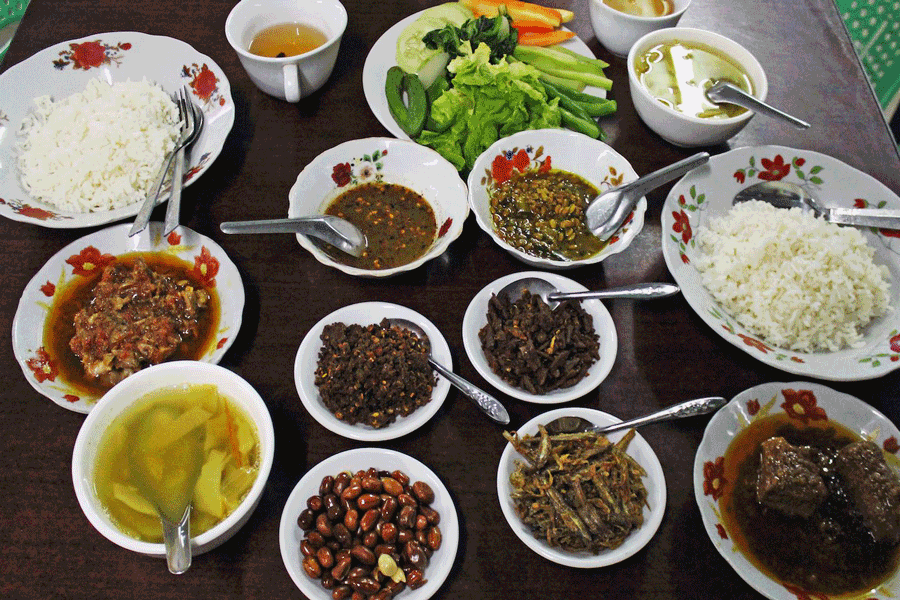 The Hu Pin Restaurant serves excellent Chinese dishes and its English-language menu is divided into three sections: chicken, pork and fish.
The Hu Pin Restaurant serves excellent Chinese dishes and its English-language menu is divided into three sections: chicken, pork and fish.
Place to eat: Kan Thar Quarter, Nyaung Shwe Township
Inn Thar Lay Restaurant
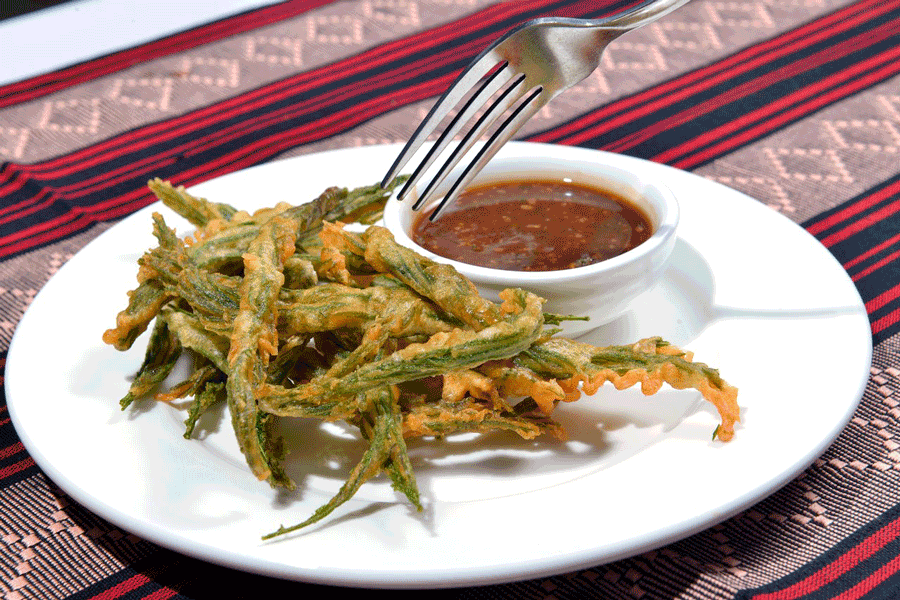 Famous for its Shan and Chinese dishes. The restaurant’s in a wooden house on stilts on the lake (like most buildings in the area) near Phaung Daw Oo Pagoda.
Famous for its Shan and Chinese dishes. The restaurant’s in a wooden house on stilts on the lake (like most buildings in the area) near Phaung Daw Oo Pagoda.
Place to eat: Near the Phaungdawoo Pagoda
Miss Nyaungshwe Restaurant
 Its menu includes all the Asian and Western dishes. Aside from the food, the good views are also one of the reasons people frequently visit; this is because of the outdoor patio. Miss Nyaungshwe also has a good selection of bottled beers.
Its menu includes all the Asian and Western dishes. Aside from the food, the good views are also one of the reasons people frequently visit; this is because of the outdoor patio. Miss Nyaungshwe also has a good selection of bottled beers.
Place to eat: Phaungdaw Seiq Road, Nyaung Shwe Township
Nam Pan Restaurant
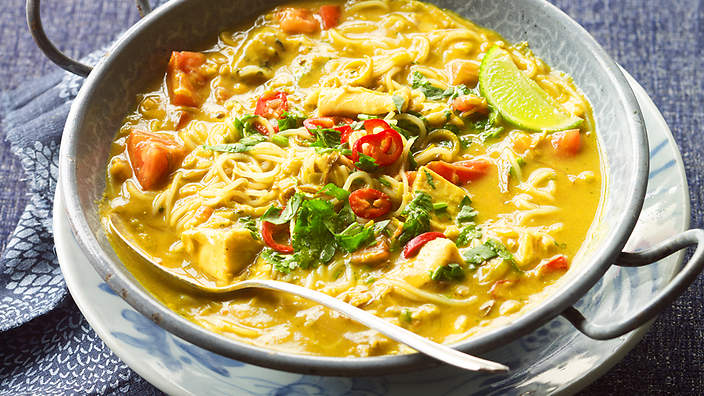 The Nam Pan Restaurant is another recommended dining spot and is found in the southern part of Inle Lake. The establishment is given thumbs up by diners and loyal patrons for their traditional Shan dishes. Chinese food is also served here.
The Nam Pan Restaurant is another recommended dining spot and is found in the southern part of Inle Lake. The establishment is given thumbs up by diners and loyal patrons for their traditional Shan dishes. Chinese food is also served here.
Place to eat: Nampan Village
Unique Superb Food House
Unique Superb is the balance of Myanmar cuisine and Western dishes. They serve local Shan and Intha dishes such as braised chicken with mint and green pepper, tofu salad, pumpkin soup, and various fish dishes and vegetable curries. Western favorites such as fried chicken, pasta, filet mignon, and French fries are also available.
Place to eat: 3 Myawady Road, Nyaung Shwe Township
Smiling Moon Restaurant
A affortable restaurant serving Inle regional dishes, hill tribe food and the traveller holy trinity of Chinese, pasta and pancakes.
Place to eat: Yone Gyi Road, Nampan Village, Inle Lake
The best time to visit Mandalay in Myanmar (Burma) are: January, November, and December are the best time to take a Mandalay tour. This time, you will experience pleasant weather with a good average temperature. Most rainfall (rainy season) is often seen in May, June, August, September, and October.
 Located in Shan State, Inle Lake is one of the popular tourist destinations in Myanmar. As it is the second largest lake in Myanmar, you may get the experience of exotic countryside views and rustic life of floating communities there. Although it has a monsoonal climate with annual average temperature of 26°C, the climate is strongly high in May, up to 30°C on average; and slightly falls in January. During the raining season, the average annual rainfall is about 1,370 mm. And, May and September are the wettest period.
Located in Shan State, Inle Lake is one of the popular tourist destinations in Myanmar. As it is the second largest lake in Myanmar, you may get the experience of exotic countryside views and rustic life of floating communities there. Although it has a monsoonal climate with annual average temperature of 26°C, the climate is strongly high in May, up to 30°C on average; and slightly falls in January. During the raining season, the average annual rainfall is about 1,370 mm. And, May and September are the wettest period.
Actually, the dry season is the best time to visit Inle Lake because the temperature is slightly cooler, with little rain. Even though it has insignificant temperature variation within the whole year, you can expect a significant temperature drop in the mornings and evenings.
The Cool and Dry Season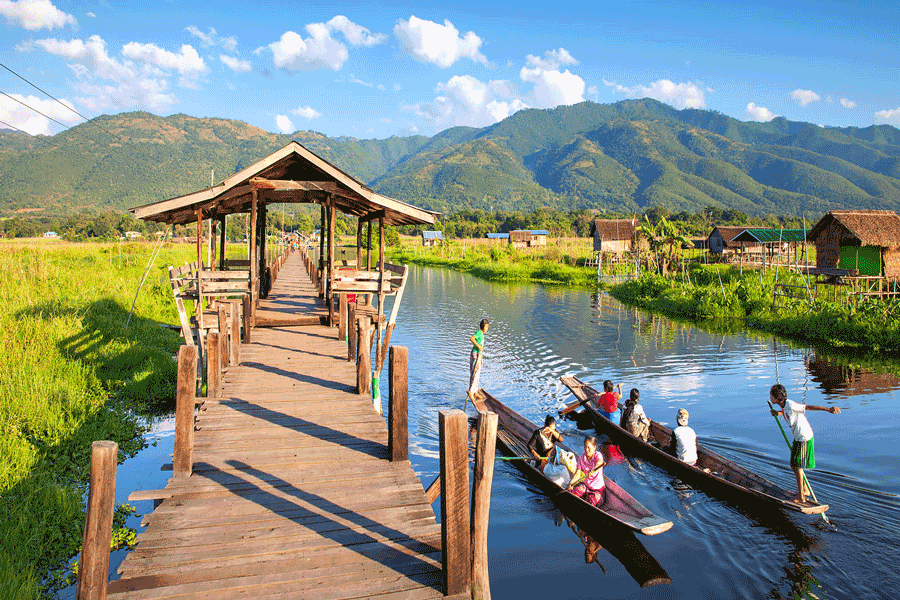 November to February is generally the cool and dry season. The coolest time is the average temperature of around 22 to 33°C (72 to 91°F); it is the best time for outdoor activities.Especially, January is the sunniest and the coldest month of the year. It has an average of 11 hours of sunshine. The day temperature may be warm, but it is cool during the evenings and mornings. A long-sleeved shirt and pants should be enough for the day but a sweater or thick jacket during the evenings and mornings to keep yourself warm.
November to February is generally the cool and dry season. The coolest time is the average temperature of around 22 to 33°C (72 to 91°F); it is the best time for outdoor activities.Especially, January is the sunniest and the coldest month of the year. It has an average of 11 hours of sunshine. The day temperature may be warm, but it is cool during the evenings and mornings. A long-sleeved shirt and pants should be enough for the day but a sweater or thick jacket during the evenings and mornings to keep yourself warm.
As it is the best time for outdoor activities, you should visit a local market, observe the indigenous lifestyle of the Myanmar people, visit the picturesque Indein Pagoda Complex, enjoy the Inle lake scene, and taste some local style wine by taking a boat. This will make you have an unforgettable experience at Inle Lake.
The Hot Season
The hot season is during March to May, but it seldom rains with the average temperature of about 24 to 35°C (75 to 95°F) and with strong sunlight and some rain. Sunscreen should be prepared for protection against sunlight.
But its hottest season is not as hot as other parts of Myanmar like Bagan. So, you can still do more outdoor activities like observing the unique fishing method of the locals, visiting their floating gardens, the local life on the lake, the houses on stilts, and also cultivating farmland on the lake itself.
During the 13th to 16th April is the Myanmar New Year, so you can also join the Thingyan Water Festival, and then culminate in the New Year Celebration on 17th April.
The Rainy Season
In the rainy season, May to October, the rain is frequent and heavy with strong winds. The temperature is cool and humid, with an average temperature between 23 and 33°C (73-91°F). If you prefer fewer crowds, you might enjoy the rainy season better.
But, September and October are the most pleasant months to visit Inle Lake because of the time of festivals, dry weather, and less rain. The weather during this period can facilitate tourists to visit their interested places more comfortably.
Throughout this article, we wish you to have an idea of how to travel to Myanmar for your best experience. In case you are looking for your own travel agent, who can offer a wonderful and hassle-free trip to Myanmar, please feel free to let us know. We always commit our best to make it your once-in-a-lifetime journey.
You may also like
The Best of Myanmar
- Depart Time:Daily
- Starts/Ends:Yangon/Yangon
- Tour type:Private Tours
- Travel Style:Nature & Adventure, Heritage Tours, Culture & History
- Activities:Local culture tours, Cultural, religious and historic sites tours, Countryside and village visits tours
- Suitable for:Solo, Family, Group, Couple
- Age range:1 To 90 Years
- Operated in:English, French, Spanish, German, Italian
Simply Yangon & Bagan 9 Days
- Depart Time:Daily
- Starts/Ends:Yangon/Yangon
- Tour type:Private Tours
- Travel Style:Heritage Tours, Culture & History
- Activities:Local culture tours, Cultural, religious and historic sites tours, Countryside and village visits tours
- Suitable for:Solo, Family, Group, Couple
- Age range:1 To 90 Years
- Operated in:English, French, Spanish, German, Italian
Highlights of Myanmar 10 Days
- Depart Time:Daily
- Starts/Ends:Yangon/Yangon
- Tour type:Private Tours
- Travel Style:Family Tours, Culture & History
- Activities:Local culture tours, Cultural, religious and historic sites tours, Countryside and village visits tours
- Suitable for:Solo, Family, Group, Couple
- Age range:1 To 90 Years
- Operated in:English, French, Spanish, German, Italian
 France
France  Spain
Spain  German
German  Italian
Italian 




 Vietnam Tours
Vietnam Tours  Cambodia Tours
Cambodia Tours  Myanmar tours
Myanmar tours  Thailand Tours
Thailand Tours  Laos Tours
Laos Tours